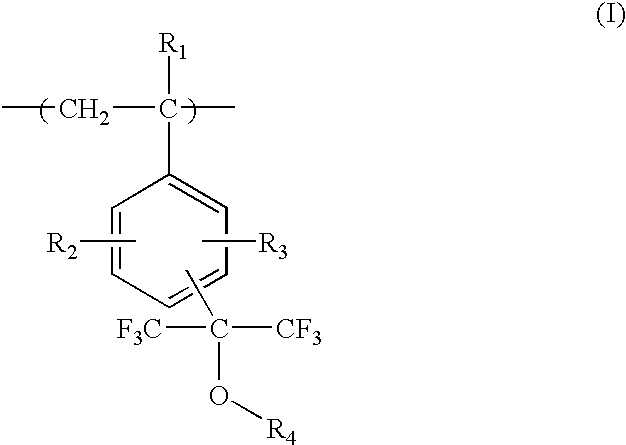Positive resist composition
- Summary
- Abstract
- Description
- Claims
- Application Information
AI Technical Summary
Benefits of technology
Problems solved by technology
Method used
Image
Examples
synthetic example 1
[0129]Into 60 ml 1-methoxy-2-propanol were dissolved 13.5 g (0.05 mol) of 4-[bis(trifluoromethyl)-hydroxymethyl] styrene and 3.4 g (0.05 mol) of methacrylonitrile. Further 0.25 g of 2,2′-azobis(2,4-dimethylvalelonitrile) (with a trade name V-65, made by Wako Pure Chemical Industries, Ltd.) was added as a polymerization initiator. The resulting solution was added dropwise over the period of 2 hours along with the injection of nitrogen gas into 10 ml of 1-methoxy-2-propanol kept at 70° C. After the completion of the addition, the mixture was agitated for additional 4 hours. The reaction mixture was poured into one liter of a mixture of methanol and ion-exchanged water (1 / 1) under vigorous stirring. The deposited resinous product was washed with ion-exchanged water, filtered and then dried under vacuum to give 14.8 g of a white resin. An NMR measurement confirmed that the product has a polymer structure represented by (I-1) / (III-2)=52 / 48 defined hereinabove, and a GPC measurement prove...
example 1
Measurement of Transmittance
[0132]As for Resins (1) to (6), a resist composition of the invention was prepared by dissolving 1.36 g of each resin, 0.02 g of the nonaflate salt of triphenylsulfonium (PAG4-3) and 0.02 g of an imidosulfonate compound (PAG6-19) in 8.5 g of propylene glycol monomethyl ether acetate, and then adding, to the solution, 0.005 g of dicyclohexylmethylamine and 0.01 g of Megafac R08 (made by Dainippon Ink and Chemicals, Inc.) as a fluorine-containing surfactant. As for Resins (7) to (12), a resist composition of the invention was prepared by dissolving 1.36 g of each resin, 0.04 g of the nonaflate salt of triphenylsulfonium (PAG4-3) and 0.02 g of an imidosulfonate compound (PAG6-19) in 8.5 g of propylene glycol monomethyl ether acetate, and then adding, to the solution, 0.005 g of dicyclohexylmethylamine and 0.01 g of Megafac R08 (made by Dainippon Ink and Chemicals, Inc.) as a fluorine-containing surfactant.
[0133]After filtered through a Teflon filter of 0.1 ...
example 2
Evaluation of Coating Performance and Development Defect
[0136]A series of resist compositions of the invention were prepared as in Example 1 except that the surfactant used in Example 1 was changed to one of the following W-1 to W-4. The surfactants used are shown in Table 5.
[0137]The surfactants used are as follows.
[0138]
TABLE 5SurfactantW1Megafac F176 (fluorine-containing, made by DainipponInk and Chemicals, Inc.)W2Megafac R08 (fluorine-containing andsilicon-containing, made by Dainippon Ink andChemicals, Inc.)W3Polysiloxane polymer KR-341 (made by Shin-EtsuChemical Co., Ltd.)W4Polyoxyethylene nonylphenyl ether
[0139]After filtered through a Teflon filter of 0.1 μm pore size, the solution of each sample was coated on a silicon wafer that had been treated with hexamethyl disilazane with use of a spin coater, and dried on a vacuum contact type-hot plate kept at 110° C. for 90 sec to give a 0.3 μm thick resist film. The coated film was subjected to an image exposure with a KrF excimer...
PUM
| Property | Measurement | Unit |
|---|---|---|
| Percent by mass | aaaaa | aaaaa |
| Percent by mass | aaaaa | aaaaa |
| Wavelength | aaaaa | aaaaa |
Abstract
Description
Claims
Application Information
 Login to View More
Login to View More - R&D
- Intellectual Property
- Life Sciences
- Materials
- Tech Scout
- Unparalleled Data Quality
- Higher Quality Content
- 60% Fewer Hallucinations
Browse by: Latest US Patents, China's latest patents, Technical Efficacy Thesaurus, Application Domain, Technology Topic, Popular Technical Reports.
© 2025 PatSnap. All rights reserved.Legal|Privacy policy|Modern Slavery Act Transparency Statement|Sitemap|About US| Contact US: help@patsnap.com



